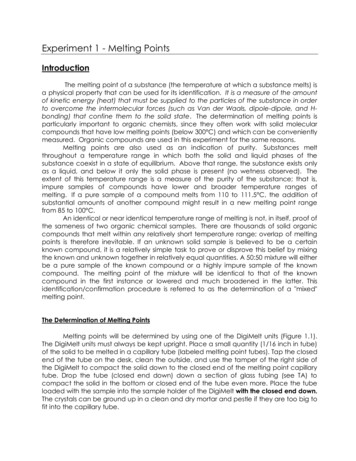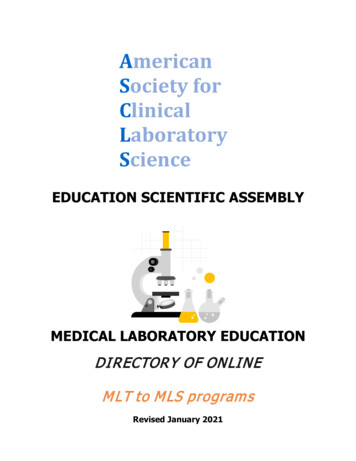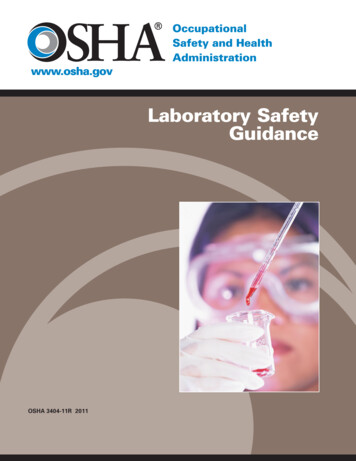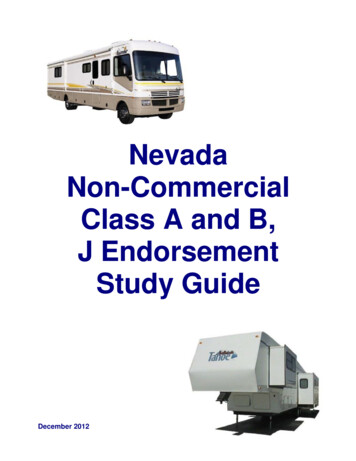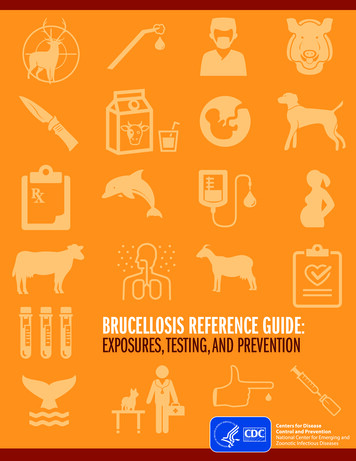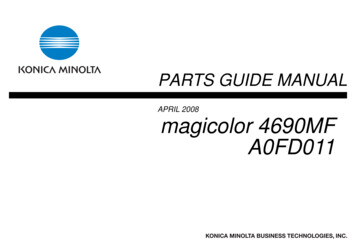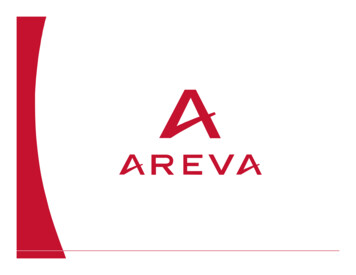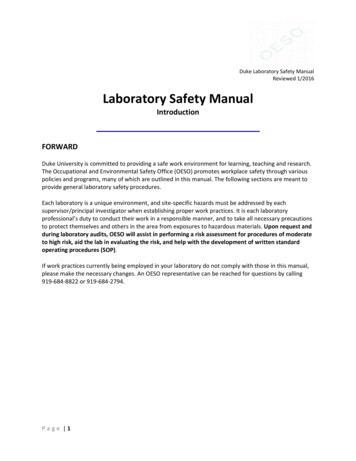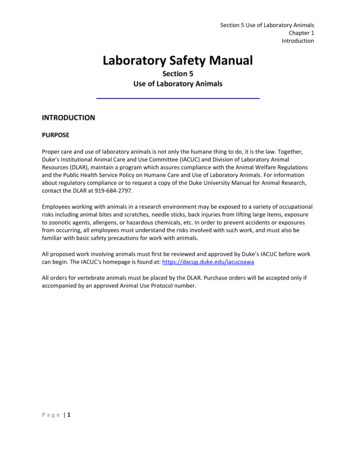
Transcription
Section 5 Use of Laboratory AnimalsChapter 1IntroductionLaboratory Safety ManualSection 5Use of Laboratory AnimalsINTRODUCTIONPURPOSEProper care and use of laboratory animals is not only the humane thing to do, it is the law. Together,Duke’s Institutional Animal Care and Use Committee (IACUC) and Division of Laboratory AnimalResources (DLAR), maintain a program which assures compliance with the Animal Welfare Regulationsand the Public Health Service Policy on Humane Care and Use of Laboratory Animals. For informationabout regulatory compliance or to request a copy of the Duke University Manual for Animal Research,contact the DLAR at 919-684-2797.Employees working with animals in a research environment may be exposed to a variety of occupationalrisks including animal bites and scratches, needle sticks, back injuries from lifting large items, exposureto zoonotic agents, allergens, or hazardous chemicals, etc. In order to prevent accidents or exposuresfrom occurring, all employees must understand the risks involved with such work, and must also befamiliar with basic safety precautions for work with animals.All proposed work involving animals must first be reviewed and approved by Duke’s IACUC before workcan begin. The IACUC's homepage is found at: https://dacup.duke.edu/iacucoawaAll orders for vertebrate animals must be placed by the DLAR. Purchase orders will be accepted only ifaccompanied by an approved Animal Use Protocol number.P age 1
Section 5 Use of Laboratory AnimalsChapter 2Animal HandlingANIMAL HANDLINGAll employees who work with live animals are required to complete the Placement Health Review forAnimal Handlers. This form will be reviewed by Employee Occupational Health and Wellness (EOHW),which administers all applicable medical surveillance. For more information, contact EOHW at 919-6843136.Personnel Training:Duke’s IACUC provides animal care and use training sessions which are mandatory for all animalhandlers. Required sessions are available online. These trainings provide detailed instruction on bothregulatory compliance and basic husbandry. Because hazards vary from lab to lab, it is also necessary foreach principal investigator (PI) to provide site-specific instructions for conducting animal work safely.This would include information on any etiologic agents, chemical hazards, radiation hazards, behavioralconcerns of a particular animal species, etc. In addition to identifying the risks, the PI is also responsiblefor providing appropriate personal protective equipment such as lab coats, disposable gloves, gogglesand face shields.Husbandry (DLAR website):Animals shall be provided nutritionally adequate food, potable, non-contaminated water and a sanitaryenvironment in which the animal’s health shall not be affected.Injections:All sharps shall be disposed of immediately after use in an approved sharps container. Needles shall notbe broken, bent, or recapped before disposal. A one-handed recapping procedure may be incorporatedonly after approval by the OESO-Biological Safety Division 919-684-8822. Physical restraint proceduresshould be developed and practiced to prevent accidental autoinoculation while at the same timereducing stress on the animal.Animal Restraint:Proper restraint and handling techniques are essential for reducing stress to laboratory animals, while atthe same time allow animal care workers to perform their work with less chance of being scratched,bitten, kicked, etc. Animals can be restrained either manually or with restraint devices. It is theresponsibility of the PI to train their staff on proper restraint for each species used.Changing Bedding:Precautions should be taken, while changing animal bedding, to minimize or eliminate the aerosolizationof hazardous agents which may have been shed by the animal. The use of a biological safety cabinet(BSC) or chemical fume hood should be used when changing animals dosed with hazardous agents.Many allergens can also be aerosolized during bedding changing. Some options include the use of a cagechanging station, or decontaminating the soiled bedding before disposal by placing the whole cage in aP age 2
Section 5 Use of Laboratory AnimalsChapter 2Animal Handlingbiohazard bag and then autoclaving it. Cage changing stations are not appropriate for animals dosedwith biohazardous material and autoclaving may not be appropriate for those dosed with chemicaltoxins. Please read and adhere to the procedures in the written standard operating procedures (SOP)for handling animals dosed with these hazardous materials.Allergens:Laboratory animal allergies and associated asthma are among the most common conditions affectingindividuals who work with laboratory animals. Typically, allergies to animals result from repeatedexposure to an animal’s dander, urine, saliva, serum, or other body tissues. Symptoms can range frommild (e.g. itchy or runny nose and eyes) to severe (e.g. shortness of breath or red, itchy wheals on skin).Levels of airborne allergens tend to rise significantly with certain activities such as changing or cleaninganimal cages. To reduce the levels of airborne allergens, OESO recommends using: Ventilated hoods (cage changing station, biological safety cabinet (BSC), or chemical fume hood)for cage changingDust-free bedding, orFiltered caging systems.If these options aren’t available or feasible for a particular situation, then personal respiratoryprotection may be required. Contact Occupational Hygiene and Safety (919-684-5996) for moreinformation about respirators. Make an appointment with Employee Occupational Health and Wellness(919-684-3136) or Student Health (919-681-WELL) if you have allergy concerns.Carcass Disposal:All non-radioactive animal carcasses are to be collected by the DLAR staff and incinerated. For moreinformation, contact the DLAR at 919-684-5567.Radioactive carcasses and their associated lab waste (i.e. bedding, excreta, sharps, etc.) are to bebagged and sealed in 3 mil plastic bags. Make sure that all sharps are contained in a puncture resistantcontainer before placing in plastic bags! Once properly barcoded, the bags are refrigerated in a lined 30gallon plastic drum. All packaging and labeling materials are provided by the OESO. For moreinformation contact the OESO- Environmental Programs Division at 919-684-2794.P age 3
Section 5 Use of Laboratory AnimalsChapter 3Working with Hazardous MaterialsWORKING WITH HAZARDOUS MATERIALSStandard operating procedures (SOPs) must be developed and approved by OESO for any work whichinvolves the use of hazardous materials in animals. Such procedures shall detail the safe handling of theanimal throughout the duration of exposure. For work with biological agents in animals, see the Guide for Developing an SOP for the Use ofBiohazards in Animals. Contact Biological Safety Division (919-684-8822) for assistance.Animal Biosafety Levels (ABSL):Work involving the exposure of animals with biological materials must be conducted at the appropriatecontainment level to ensure adequate protection of personnel and the environment. The followingtable summarizes the Center for Disease Control and Prevention's four animal biosafety levels.ABSL AgentsPracticesSafety Equipment(Primary Barriers)Facilities(Secondary Barriers)As required for care ofeach speciesStandard animal facility non-recirculationof exhaust air directional airflowrecommended1Not known to causedisease inimmunocompetentadult humansStandard animal care andmanagement practices,including appropriatemedical surveillanceprograms2Associated withhuman disease.Hazard:autoinoculation,ingestion, mucousmembrane exposureABSL-1 practices plus:P age 4 ABSL-1 equipmentABSL-1 facility plus:primary barriers:limited access containment autoclaveequipmentbiohazard warningavailableappropriate forsigns handwashing sinkspecies: PPE:sharp precautionsavailable in thelaboratory coats,biosafety manualanimal roomgloves, face anddecontaminationrespiratoryof all infectiousprotection aswastes and ofneededanimal cages priorto washing
Section 5 Use of Laboratory AnimalsChapter 3Working with Hazardous MaterialsABSL Agents3Indigenous or exoticagents with potentialfor aerosoltransmission; diseasemay have serious orlethal consequencesPracticesSafety Equipment(Primary Barriers)Facilities(Secondary Barriers)ABSL-2 practices plus:ABSL-2 equipment plus:ABSL-2 facility plus: 4Dangerous/exoticagents which posehigh risk of lifethreatening disease,aerosol-transmittedlab infections; orrelated agents withunknown risk oftransmissioncontrolled accessdecontaminationof clothing beforelaunderingcagesdecontaminatedbefore beddingremoveddisinfectant footbath as neededABSL-3 practices plus: entrances throughchange roomwhere personalclothing isremoved andlaboratoryclothing is put on;shower on exitingall wastes aredecontaminatedbefore removalfrom facility containmentequipment forhousing animalsand cagedumpingactivitiesClass I or IIbiosafetycabinets availablefor manipulativeprocedures(inoculation,necropsy) thatmay createinfectiousaerosols. PPE:appropriaterespiratoryprotectionABSL-3 equipment plus: maximuncontainmentequipment(i.e.Class IIIbiosafety cabinetor partialcontainmentequipment incombination withfull body, airsupplied positivepressurepersonnel suit)used for allprocedures andactivities physicalseparation fromaccess corridorsself-closing,double dooraccesssealedpenetratorssealed windowsautoclaveavailable infacilityABSL-3 facility plus: separate buildingor isolated zonededicatedsupply/exhaust,vacuum anddecontaminationsystemsotherrequirementsoutlined in thecompletedescription ofABL-4Summarized from Biosafety in Microbiological and Biomedical Laboratories, 5th Edition, 2009.P age 5
Section 5 Use of Laboratory AnimalsChapter 3Working with Hazardous Materials For work with hazardous drugs or other toxic chemicals in animals, see the SOP for Work withToxic Chemicals in Animals. Contact Occupational Hygiene and Safety (919-684-5996) forassistance.For work with radioactive materials in animals, use Radiation Safety’s Animal Care and UseProtocol Wizard online or contact the Radiation Safety Division (919-684-2194) for questionsabout SOP development.Safe Use of Anesthetic Gases:Many anesthetic gases are used at Duke University for performing animal surgeries. These gases canpresent a risk for potential exposure to the lab personnel performing the surgeries. Anesthetics ofconcern include ether, nitrous oxide, and halogenated agents (e.g. halothane, isoflurane,methoxyflurane). Some of these halogenated anesthetics have been linked to adverse health effects inexposed workers, such as reproductive and neurological effects. Emphasis must be placed on protectingpersonnel from exposure by adequately “capturing” the waste gas being generated. This may beaccomplished by several methods depending on the method of delivery of the gas:For enclosed chambers (e.g. Bell jar) Perform work in a fume hood so when lid is removed, gases are captured by hood.Evacuate chamber via building vacuum system prior to removing lid.Make sure the chamber lid is tight-fitting.Remove chamber lid only when animal is being placed into or removed.For anesthetic gas machines and vaporizers Verify that proper filtration canisters are installed.Maintain filter canisters according to manufacturer’s specifications.Choose an appropriate sized face-piece to ensure most efficient waste gas recovery.Maintain anesthesia machines and vaporizers according to manufacturer’s instructions and inaccordance with the Animal Care and Use Program’s Policy on Safe Use of Anesthetic Gases.Lab personnel who are concerned with possible exposure to anesthetic gases may contact theOccupational Hygiene & Safety division of OESO at 919-684-5996 to request an exposure risk evaluation.REFERENCESGuide for the Care and Use of Laboratory AnimalsNIH Guidelines for Research Involving Recombinant DNABiosafety in Microbiological and Biomedical LaboratoriesP age 6
Proper care and use of laboratory animals is not only the humane thing to do, it is the law. Together, Duke's Institutional Animal Care and Use Committee (IACUC) and Division of Laboratory Animal . For work with biological agents in animals, see the Guide for Developing an SOP for the Use of Biohazards in Animals. Contact Biological Safety .

